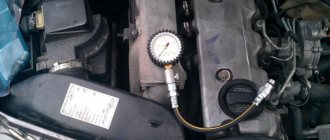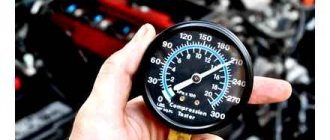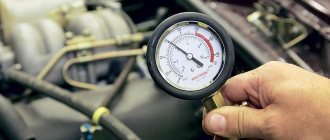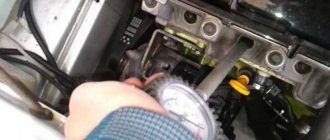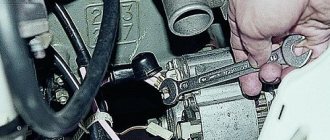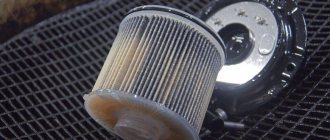05 February 2016 Lada.Online 76 159 10
How to quickly and accurately determine the condition of the engine? Check the compression in the cylinders! Is the engine running rough, you feel a loss of power, the consumption of engine oil or fuel has increased and the car has become difficult to start in cold weather? All of these problems may be caused by low compression in one or more cylinders.
Compression measurement
A compression test is carried out for a general assessment of the technical condition of the parts of the cylinder-piston assembly and the engine valve mechanism. The check is carried out with the engine warmed up to operating temperature. We increase the pressure in the engine fuel system (see “Replacing the fuel filter”) and do not replace the fuel pump fuse. We unscrew the spark plugs from the cylinder head (see “Checking the condition and replacing the spark plugs”). Disconnect the engine management system wiring harness assembly from the ignition coil wiring harness assembly (see “Engine Removal and Installation”).
Install the compressor tip into the spark plug hole of the cylinder head. We connect the wire terminal to the negative terminal of the battery. We turn the crankshaft with the starter while the accelerator pedal is fully pressed for 2-4 seconds (the pressure gauge should stop rising). We record the pressure gauge readings and relieve the pressure in the compressor. To correctly assess compression, the battery must be fully charged - the crankshaft speed when cranking must be at least 180 min -1. Similarly, we check the compression in other engine cylinders. The compression of a running engine should be between 11.0 and 13.0 bar, and the difference in cylinder readings should not exceed 2.0 bar. To find out the reasons for low compression, pour 10-15 cm 3 of engine oil into the cylinder through the spark plug hole and repeat the measurement. If, upon repeated measurements, the compression increases by more than 2.0 bar, the most likely cause of the malfunction is severe wear, blockage or breakage of the piston rings. If after filling the oil the pressure gauge readings do not increase, the valve discs most likely will not fit into the cylinder head sockets. This can occur if the valve actuator is malfunctioning, or if the valve poppets or seats are severely worn, burned, or damaged. The cause of the malfunction can only be definitively determined after disassembling the engine.
On new Lada Priora engines, the compression in each cylinder must be at least 16 atmospheres. And if, when replacing it, it turns out that in one or more cylinders these readings differ greatly from the maximum, then more thorough diagnostics of the engine is required and identification of the problems that caused such a decrease.
To check the compression on the Priora yourself, we will need:
- Candle head
- Extension
- Ratchet or crank
- Compressor
- Head 10 mm
Motor Lada Priora (126 and 127): breakdowns and service life must be checked
The engine is the basis of any car - without it there is no movement and Drive! The engine on the Priora comes in 2 modifications: 21126 and 21127, the second is essentially a modified 126 engine, which has been installed on Lada Priora since 2013. after restyling the Lada Priora car model.
126 engines (16 valves) are high-torque after 1000 rpm, and up to 4000 - this is the maximum torque, after 4 thousand the torque decays. The 127 engine, due to the distributed air intake, pulls well from below, damping out at about the same rate as its brother. If the running-in was carried out properly, then the engine life will be close to 200 thousand km. Overhaul of the engine of a Priora car, like the entire AvtoVAZ range, is subject to the garage - there is nothing supernatural about it.
The price of spare parts is more expensive than tenths, but cheaper than foreign ones. Engine power of 98 and 106 hp allows you to feel confident on the road - well, certainly not a vegetable. I consider the main 2 disadvantages of the engine to be the unit: pump roller, timing belt. If one of these spare parts fails, the valve bends. 2 minus - camshaft plugs: when these rubber bands dry out at low temperatures, they are squeezed out along with the oil.
If you don’t see this in time, there will be trouble! The fact that hydraulic compensators knock when cold is considered the norm - you can close your eyes to this, there will be no harm.
In the vast majority of cases, Lada Priora cars are equipped with a 16-valve engine (the 8-valve engine was “inherited” from the “ten” and was not warmly received by car enthusiasts due to its sluggishness, but it has a huge advantage over the 16-valve engine - it does not bend valve).
The first 16 valve engine received number 126, the second – 127. The characteristics of the Priora engine No. 126 turned out to be so good and optimal that the car with this engine was sold most often. Repair of the Priora engine with 16 valves is not carried out so often, but you will have to look into it at least once every six months - in order to make sure with your own eyes that everything is in order with it. In addition, you need to keep an eye on the timing belt - if you miss this unit, you can get into big money. Read the article to the end, and we will tell you about these 2 units.
126 Priora engine - looks like this
Motor 126 and 127: working life, differences
These engines on Priora had a displacement of 1.6 liters (or 1596 cm3). Optimal for city sedans, the engine size of the Lada Priora gave a good combination of dynamics and consumption: along with very decent acceleration, fuel consumption does not exceed sky-high numbers. Both engines received good marks, because the car behaved perfectly in the city and on the highway.
In fact, the 126 Priora engine became the first sixteen-valve engine for this model, and the 127 is a modified version, “overclocked” by AvtoVAZ designers. In addition to the same engine displacement, they have other identical characteristics. The in-line type of arrangement of four cylinders provides a simplified design that can be repaired on your own.
The distributed multipoint injection system is involved in creating a good, rich fuel-air mixture (a lean mixture can lead to breakdowns). The cylinder diameter is 82 mm, the piston stroke is 75.6 mm, the compression ratio is 11. The “engines” fall under the Euro 4 standard, they are powered by gasoline with an octane rating of 95.
The 126 engine for the Priora received the following characteristics: 98 hp. (72 kW at 5600 rpm), acceleration to 100 km/h in 11.5 seconds (with manual transmission), city consumption 9.1 l - 100 km (manual transmission), maximum torque - 145 Nm.
The 127 engine for the Priora was upgraded to the following figures: 106 hp. (78 kW at 5800 rpm), acceleration to 100 km/h in 11.5 seconds (with manual transmission), city consumption 8.9 liters per 100 km (with manual transmission), maximum torque – 148 Nm.
The difference may not seem so noticeable, but this is a very small but strong step in design on the part of AvtoVAZ (this is where the change to sixteen-valve “engines” with a volume of 1.6 liters ended). For a car of the Lada Priora class, the engine power was sufficient.
In the same block it is necessary to say about the operating temperature. An absolutely normal operating temperature is considered to be between 90 and 95 degrees Celsius. Further, when the car is being pushed in a traffic jam, is basking in the sun, or for some other reason, but can still work - from 97 to 110 degrees. The engine is slow in places and wears out a lot, but you can still get to your destination. A temperature below 90 degrees is a direct sign indicating that the car has not yet warmed up, and it is better to wait in place until the arrow points to the coveted 80-90 mark.
Operating a car at temperatures above 110 degrees is dangerous because the service life of the engine is noticeably reduced - hot parts undergo very severe wear, overcoming the force of friction.
In general, the service life of the Lada Priora engine with a normal driving style and careful treatment is 200,000 km - after this mark the time comes when the “engine” requires major repairs. AvtoVAZ mentioned the timing belt separately as a recommendation, saying that it needs to be checked every 100,000 km (many car enthusiasts talk about the figure of 50,000 km).
All Lada engines have a problem, and it is related to the valves, which will be discussed further.
Are the valves bending?
When the timing belt breaks on a Priora, the valves will bend. That is why it was said above how often you need to check it for damage. Any crack or tear can be the start of a very fun adventure: when the belt breaks, the car will not move under its own power and will have to be rescued from the scene of the breakdown.
How much does engine 126 and 127 cost?
Engine 126 has catalog number 21126100026030, sells for about 107,000 rubles, engine 127, respectively, has catalog number 21127100026030, its price is slightly higher by 3-5 thousand rubles. The price on the secondary market will be significantly lower (up to 20-25 thousand rubles), but the savings will not pay off - a used “engine” can last no more than 1000 km, this is a real lottery.
How to find out what engine is in a Priora
You can find out by looking at the plate on the left glass of the rack, where the engine number is written on the edge. From it you can understand the 8-valve unit, or 16. You can also recognize the modification 21126 or 21127.
Signs of the need for internal combustion engine repair
The reasons why the operation of the engine is disrupted are arranged in a small list, starting with refusal to start and ending with floating idle speed (this problem was removed on the 127 “engine”). Not all breakdowns end in capital damage - sometimes it’s enough to add oil, sometimes it’s enough to adjust the ECU settings.
Compression reduction
A decrease in cylinder compression below 16 atmospheres is a bad sign. Such a high limit corresponds to a compression ratio of 11.
If the compression decreases (or vice versa increases), then the “engine” will have to be rebuilt.
Knocks in the engine
Engine knocks can come from several points. These could be hydraulic compressors, timing belt rollers or pins. The knocking noise could also be caused by low oil level. The answer to the question will be given by a thorough detailed inspection of all parts of the unit and checking the oil level.
Blue smoke from the exhaust pipe
The blue smoke that comes from the exhaust pipe appears when oil enters the combustion chamber. It can leak either from the valves or from under the piston. The result is the same: the oil is eaten up and blue smoke pours out of the chimney. Once the leak is located, half the problem will already be solved.
Troit motor
Sometimes in the cold the engine may stall - don’t be alarmed by this, because it may simply be one of the spark plugs that fails. In this case, we advise you to simply restart the engine and it will stop running.
How much does it cost to overhaul a Priora engine - average price
Self-repair of a Priora engine with 16 valves costs an average of 16-20 thousand rubles. The cost depends on the severity of the breakdown and may be lower or higher than this average range. Repairing a Priora engine can be entrusted to the wrong hands, but then you will have to pay for the work - sometimes the cost of repairs reaches as much as 40 thousand rubles.
This is an unreasonably inflated figure, because, as practice shows, you can rebuild the engine on a Priora, working at a moderate pace, in just three days - and three days of work is definitely not worth that kind of money. Don’t be afraid of not being able to cope - your Lada is easy to repair, and using the advice and “tutorials”, you will conquer even such a task that is impossible at first glance.
Source: https://priorik.ru/126-i-127-dvigatel-na-prioru-16-klapanov-resurs-priznaki-polomki/
Procedure for checking compression on a 16-valve Priora engine
We will immediately show how to perform this procedure on a 16-valve engine, since on an 8-valve engine everything is much simpler and no questions will arise.
- The first step is to warm up the engine to operating temperature.
- Remove the top plastic cover
- Unscrew the bolts securing the ignition coils and remove them
- Remove all 4 spark plugs
Now you need to turn off the power to the coils by disconnecting the wire block, as shown in more detail in the photo below.
You can now screw the pressure gauge fitting into the cylinder 1 spark plug hole, which is clearly shown below.
Now you need to turn the starter while pressing the accelerator pedal all the way. At this stage, you need to fix the device so that it is securely fixed, or ask an assistant to hold it in their hand. It is necessary to crank the starter until the pressure stops increasing.
Typically, 4 starter revolutions are sufficient to create maximum pressure in the cylinder. At the same time, the photo shows that the compression in the first cylinder is 16 atm. In the same way we take measurements on the other three cylinders. But before you unscrew the device, you need to release the pressure by pressing the appropriate reset button.
If during the measurement it turns out that the compression is practically the same in all cylinders, and is also at least 12 atmospheres (at least), then this can be considered the norm. Although ideally it should not fall below 13-14 on the 21126 engine.
If it is discovered that the compression varies greatly in one or more cylinders (by atmosphere), it is worth conducting additional engine diagnostics. We fill the problematic cylinder with several “cubes” of clean motor oil, then measure again. If in the second case the compression has increased, most likely the reason is in the piston rings, that is, wear.
If the pressure remains the same, that is, has not changed, then most likely the reason is in the valves or other problems with the cylinder head.
What compression should the VAZ-2109 injector and carburetor have?
What is engine compression. How to check the compression of a VAZ 2109? Often, car owners are faced with vibration that unexpectedly occurs when driving at idle speed, and large fuel combustion. There are several reasons for this deficiency, for example, problems with spark plugs or malfunctions of the fuel system.
Poor engine compression can also lead to such consequences. If diagnostics of the fuel system shows that everything is in order, you need to check the compression in the cylinders.
Compression is the maximum pressure in the cylinder that occurs at the end of the compression stroke (at the moment the piston reaches top dead center). To measure compression there is a special device called a compression gauge (a pressure gauge with a hose and a fitting at the end).
What is engine compression. How to check the compression of a VAZ 2109?
Poor compression in the cylinders leads to the following consequences:
- fuel consumption increases;
- dynamics deteriorate (acceleration);
- the accelerator responds poorly to the pedal;
- poor “traction”;
- black exhaust appears.
Checking the compression of the VAZ 2109 engine with your own hands
- Before measuring compression, you need to check the valve clearances and adjust them.
- Warm up the engine to 70-80 degrees.
- Turn off the engine, remove the spark plugs (to do this, use a spark plug wrench).
- Disconnect the fuel hose and clamp it to prevent fuel from leaking.
- Remove the central drive from the ignition coil.
- Use a compression gauge installed in the spark plug socket to determine the indicators.
Start checking from the first cylinder. Each cylinder must be checked separately. - At this time, the assistant must turn the starter so that the compression gauge can record the resulting pressure.
- Record the device indicators.
The minimum permissible compression is 10 kg/sq. cm, and the spread between the cylinders should not exceed 1 kg/sq. see. If your readings differ greatly from each other, we can conclude that there is wear on the compression rings, valves that do not fit well on the seats, or problems with the tightness of the cylinder head gasket.
If the cylinder compression is less than the figure indicated above or is different in each cylinder, a major overhaul of the engine is required.
Most likely, you will have to change the cylinder head gasket, grind in and adjust the valves, and install new piston rings. It is possible that the piston rings are stuck, then the engine will have to be decarbonized.
To narrow down the range of possible problems, you need to do a few simple tests with an air compressor.
- Set the piston of the cylinder being tested to the top dead center position.
- Tighten the handbrake, turning on speed 4-5.
- Start the compressor and supply air under pressure to the cylinder.
Monitor the air flow
- If you hear a hissing sound in an adjacent cylinder, there is most likely damage to the gasket between the cylinders. To solve this problem, you need to replace the cylinder head gasket.
- To make sure that there are no breakdowns in the engine cooling system, you need to remove the radiator cap or expansion tank and make sure that the coolant level does not increase when air is pumped. A breakdown may be indicated by air bubbles or a change in the color of the coolant, or the appearance of an exhaust odor.
- If there is a hissing sound in the manifold or exhaust pipe area, it is most likely due to the intake or exhaust valve.
Source:
How to diagnose a VAZ 2108-21099 engine using a compressor
Only experienced specialists can visually clearly identify this or that engine problem; it is quite difficult, almost impossible, for an ordinary driver to do this. Of course, you can notice potential problems by the exhaust or sound, but this is only a small part of all possible malfunctions.
More accurate diagnostics are performed using serious instruments. This article will discuss engine diagnostics, which are more complex than visual, using simple, simple instruments.
Diagnosis of the VAZ 21099-2109-2108 engine using simple DIY tools
What is needed for diagnosis:
- a compression meter that measures compression in the cylinders;
- an oily rag that is used to determine the compression stroke of the engine. A tool made by combining a fitting for spark plug holes and a regular whistle will be convenient and effective;
- adapter for spark plug holes, which is used in the process of checking the tightness of the combustion chamber, compressor for inflating wheels.
Diagnostic procedure
The operating algorithm is as follows:
- It's better to start with compression. First, you need to warm up the engine to operating temperature, and then turn off the fuel supply. In this case, the hose on a carburetor engine is removed, compressed and pinched with something, or simply lowered into some container.
- For an injection engine, everything is much simpler - you just need to pull out the fuel pump fuse. Then you need to start the car (there should be some fuel left in the fuel rail) and wait until the engine stalls.
- After this, the ignition system is turned off, for which the central wire is removed from the distributor, and the sensor on the injector that monitors the position of the crankshaft is turned off.
- All debris that has accumulated there must be removed from the spark plug wells so that it does not get into the cylinders. After this, all the candles are unscrewed.
- Next, the compression gauge fitting is screwed in or inserted—it all depends on the model—after which the assistant begins to start the engine. The starter must rotate the engine until the pressure gauge needle stops in one position. Such measurements are carried out on each cylinder, and their results are recorded.
There is a special formula with which the ideal compression can be calculated for any engine. Compression is 1.2* compression ratio.
For example, the VAZ 21083 engine has a compression ratio of 9.8. Thus, its compression will be equal to 1.2 * 9.8 = 11.76.
This means that a compression of 11-12 atmospheres is quite normal for this engine. But each measurement has its own errors.
What factors may influence measurements?
- only a new or well-repaired car can have a compression of 12 atmospheres, for example, after an engine overhaul;
- a cold engine that has not reached operating temperature will have significantly lower compression;
- if the battery is weak or begins to “crumble”, then the engine will not turn so fast, so in this case the compression will be less;
- compression increases due to the combustion of oil in the cylinders - as a result of its combustion, the connection is sealed.
- Having recorded all the measurement data, it is necessary to analyze it. The spread of results for all cylinders should not exceed one atmosphere. For example, if in one cylinder the compression is 9 atmospheres, and in the other three – 11, then in this case you need to think about it. To more accurately determine the nature of the malfunction, it is necessary to carefully monitor the pressure gauge readings, or more precisely, how the pressure increases with each crankshaft revolution.
If at the first revolution there is low pressure (3-4 atm.), and with subsequent revolutions it increases, this indicates wear on the cylinders or problems with the rings. In this case, when about 10 cubes of engine oil are added to the cylinder, an increase in compression will be observed already with the first revolution.
When at the first revolution a compression of 5-8 atmospheres is observed, and with subsequent revolutions the picture practically does not change, this indicates possible valve deformation or a leaking cylinder head gasket
Important! A serviceable engine at the first revolution “produces” 6-8 atmospheres, and with subsequent revolutions it “pushes” up to 11-12 atmospheres.
After analyzing the overall results, we can draw the following conclusions:
- compression of 0-4 atmospheres indicates a probable burnout of the piston, valve or cylinder head gasket;
- compression 4-6 atm. usually indicates broken piston rings or partitions between these rings;
- if the compression in each cylinder is approximately the same and amounts to 8-10 atmospheres, then this indicates wear of the cylinder-piston group, so it is necessary to prepare for the upcoming engine overhaul;
- A new and run-in engine can have a compression of 12-12.5 atmospheres.
If a car with decent mileage produces results equal to or higher than normal, this indicates that oil may have gotten into the cylinders. The probable reason for this is wear of the cylinder-piston gear or valve guides.
Now it is necessary to compare the obtained data with the results of a visual inspection.
So, everything has been examined, an analysis has been carried out and the problematic cylinder has been found. But the overall picture still requires clarification. In this case, it is necessary to check the cylinder for leaks.
Leak test
You can check the tightness of the cylinder as follows:
- Use an oiled rag or the previously described device with a whistle to close the hole in the problem cylinder.
- It is also necessary to lift the car (it is enough to lift one drive wheel). Everything will be much simpler if there is a “crooked starter”.
- When the top gear is engaged, you need to turn the drive wheel or turn the engine using a crooked starter in neutral gear. It is necessary to rotate the crankshaft until the oily rag flies out or the whistle begins to whistle. Using this simple method, you can determine the compression stroke in the required cylinder.
- Next, the car is lowered, the handbrake and gear are engaged, after which the suspicious cylinder is inflated by a compressor (in extreme cases, air from the wheel can be used).
By the hiss of air you can get a more accurate picture:
- air escaping from the adjacent spark plug hole indicates a burnt-out cylinder head gasket;
- air escaping from the carburetor indicates a problem with the intake valve;
- A hissing sound in the muffler indicates a burnt out exhaust valve. A side effect of this malfunction is the engine “triggering” and smoking. This problem is the most common;
- Air coming out of the crankcase gas outlet indicates piston burnout or ring wear.
So, using the simple procedures described above, you can accurately determine whether this car is worth buying (if this was the purpose of the diagnosis), or find out whether your favorite car needs repairs.
Source:
Measuring compression in a VAZ 2109 engine
Compression in the cylinders of a VAZ 2109 engine is a very important indicator, on which not only power depends, but also the internal condition of the engine and its parts.
If the car engine is new and well run-in, then it is generally accepted that excellent compression will be 13 atmospheres.
Of course, you shouldn’t count on such indicators if your car’s mileage is already quite long and has exceeded 100,000 km, but it’s worth keeping in mind that a compression of at least 10 bar is considered the minimum acceptable.
To diagnose their VAZ 2109 engine, many people turn to specialized service stations for this procedure, although in fact this work can be done independently, having with you a special device called a compression meter.
I bought such a device for myself a few months ago, and now I measure compression on all my cars myself. The choice fell on a device from Jonnesway, since I have been using instruments from this company for quite some time and am very pleased with the quality.
Source: https://granta-service.ru/tyuning/kakaya-kompressiya-dolzhna-byt-na-vaz-2109-inzhektor-i-karbyurator.html
Video review of compression measurements on a Priora 16-cl.
In this case, the overview is shown using the 11194 engine as an example, but there is absolutely no difference when following this procedure.
I think from the video review presented everything has become more or less clear.
How to quickly and accurately determine the condition of the engine? Measure the compression in the cylinders! Is the engine failing, is there a loss of power, is there an increase in engine oil or fuel consumption, or is the car difficult to start in cold weather? All of these problems can be caused by low compression in one or more cylinders.
To ensure that the compression test gives accurate results
Compression depends not only on the technical condition of the engine, but also on the conditions under which it is measured. Make sure that when checking:
- the compressor was in good condition;
- warming up the engine to operating temperature (up to 90 degrees);
- the throttle valve was fully open;
- spark plugs in all cylinders must be extinguished;
- the appetizer worked great;
- the battery is fully charged;
- The engine air filter was clean.
What are the cylinder compression standards for VAZ engines?
Engine specifications must include "minimum cylinder compression values." If such data could not be found, determine the compression ratio yourself using the formula:
| Compression (kgf / cm2) = compression ratio (see technical specifications for internal combustion engines) * coefficient (for VAZ min 1.2, max 1.3) |
- The compression ratio of modern VAZ 21126 and VAZ 21127 engines installed on Grant, Kalina and Priora is 11. We multiply the values by the formula and get the compression ratio: 13.2..14.3.
- For the Vesta engine (VAZ-21129) the compression ratio is 10.45, the compression ratios will be: 12.5..13.6.
- For Niva (VAZ 21213, 21314) - 11.3.12.2.
If the pressure gauge readings in all cylinders are within the normal range, this does not mean that everything is in order. Different compression in the cylinders is also bad. It is important that the difference between all readings is minimal. Compare the minimum and maximum compression values in the cylinders. According to technical standards, the difference should not be more than 1 kgf/cm2 or 10%.
Reasons why there is no compression in the cylinder
Poor (small) compression in one or all cylinders indicates engine wear. There is an old and simple way to find out why compression is missing. It is necessary to pour a spoonful of engine oil into the hole in the cover and repeat the measurements:
- if the pressure has increased significantly, the tightness of the piston rings is poor;
- if the pressure has not changed, there may be several reasons (for example, a leak from the valve, broken seals under the cylinder head, there is a crack or burn in the walls of the combustion chamber, in the piston bottom).
There is another more accurate way to find out why compression has disappeared. To do this, you will need to modify the candle. We remove the insulation from it and weld the valve of the car camera to the metal body. Next, set the cylinder piston to the on position, remove the radiator and oil filler caps, screw in the product adapter and pump air into the cylinder using a pump (create pressure in it):
- if air enters the exhaust pipe, the exhaust valve is not sealed well;
- if air gets into the intake manifold, there is a problem with the intake valve.
- if bubbles appear in the expansion tank, check the cylinder head gasket;
- If there is a hissing sound in the oil filler neck, the piston rings are not tightened enough.
Engine diagnostics by measuring compression in the cylinders allows you to quickly and accurately determine their condition without disassembling, and in some cases will help avoid major engine repairs. Have you ever experienced a lack of cylinder pressure? What was the cause of the malfunction? If the engine problem persists, check the fuel rail pressure.
Arrangement of cylinders on the Prior
Let's see if this is as experienced car owners describe.
Work resource
The working life of the VAZ engine is 200 thousand km. Next, the car owner has to put the engine in for major repairs. The timing belt needs to be checked every 50 thousand kilometers. According to experienced car owners, it is because of a broken circuit that the valves bend.
The engine does not like overheating, which means it does not like the lack of oil. Car owners should carefully monitor the presence of lubricant inside the engine. Without oil, the VAZ21126 will overheat greatly, which means the engine’s already short lifespan will become even shorter.
The working life of the chain may be less than the life of the motor itself. But a broken timing belt takes valves and pistons with it. This disease was not present on VAZ 21124 engines. But such engines were installed only on Standard class Priors, that is, cheap modifications of domestically produced cars.
Similar article Engine temperature indicator and sensor on Lada Grant
Other reasons that affect the life resource:
- fuel quality. The operating book indicates the brand of fuel that the engine requires. Do not underestimate the figure under any circumstances;
- quantity and quality of oil. Experienced mechanics do not recommend pouring or adding lubricant if the car owner changes the oil himself. Do everything strictly according to the level. Such engines love semi-synthetic or fully synthetic lubricants.
Following the rules described above, the motor can last the stated 200 thousand kilometers.
Attention! Pour new oil strictly into the filler neck. You can use a funnel for the procedure.
What to do if the number is unreadable
If the number is not readable, then an examination is ordered. This procedure most often occurs at a post or during a technical inspection. When the inspector cannot read the engine number, he orders an examination.
The number cannot be read for some technical reasons or due to the large amount of rust that has eaten the metal. If the car was often driven in humid areas, in snow with increased salt deposits from ice, then the metal will be susceptible to corrosion. Of course, the embossed numbers cannot be determined.
Attention! During the examination, documents are confiscated. The vehicle is suspected of being stolen, and the code may have been broken. This cannot be avoided, so you just need to wait for the results of the examination and not rush things.
The car owner is invited to the procedure at the appointed time. The process consists of the following steps:
- Experts remove all parts from the engine compartment, which, in their opinion, will interfere with a detailed examination of the VIN code.
- Experts lubricate the remaining code with various means. It must be said right away that the examination is free, but the work of experts must be paid. Therefore, it is necessary to prepare money at the end of the procedure.
- Then the result is photographed. Photos are taken from different angles.
- They write off the vehicle coding from other parts of the car where they can be read.
Similar article VAZ 11186 engine, technical characteristics and service life
If after the procedure they were able to read the numbers, then the car owner can safely go to the MREO. If it fails, then the owner will have to wait half a month until the results are known.
During this time, it will be found out whether this car is listed as stolen, and whether the coding on it has been interrupted. If everything is in order, the documents will be returned to the car owner, and he will continue to drive the Lada Priora.
If the VIN code has rotted naturally, then this will be indicated in the documents. The car owner will be given documents, and the number will be additionally written in the technical passport
It is important to know that after painting with chemicals, the engine number can rot very quickly. Therefore, it needs to be lubricated with lithol. Painting is not recommended under any circumstances. Since the traffic police at the next check will suspect that the numbers have been interrupted. Then the car owner will have to undergo an examination again.
